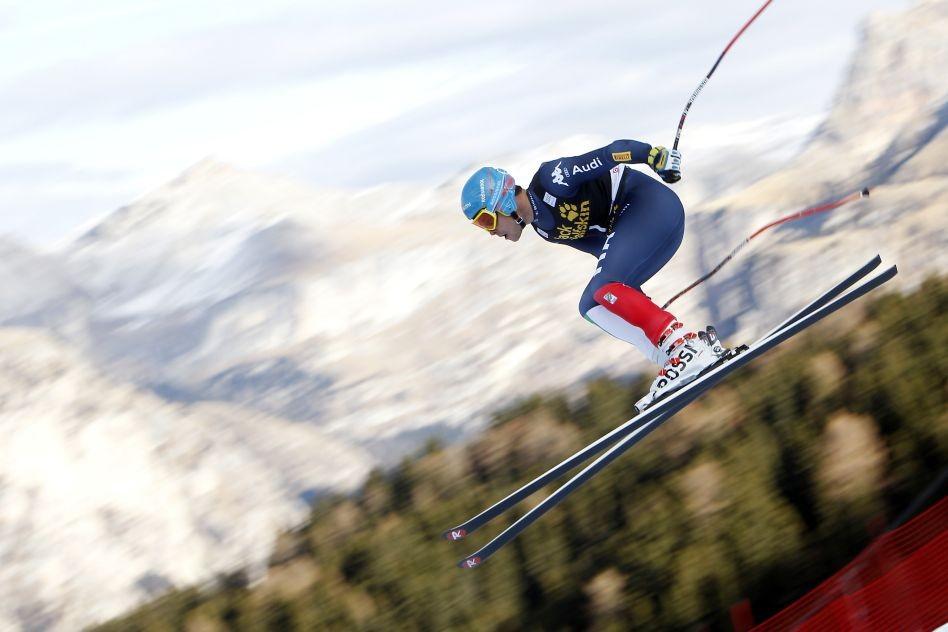Downhill skiers mix mental abandon and physical precision in breathtaking fashion
The Lauberhorn is not so much the Grand National of alpine racing as the Epsom Derby

Is it a bird? Is it a plane? No! It’s Christof Innerhofer… Man and superman, surely too close to the sun even as he clatters over the ice, one of that heedless, restless breed who today embrace one of the most significant challenges in all sport: the downhill classic on the Lauberhorn.
It may not mean much to you, as a rare frost spreads its brittle web over the muddy plains of our island. Throughout Europe, however, millions of highlanders idolise the men whose deeds, under the baleful gaze of the White Spider, make Tony McCoy look like the bowls captain of the Basingstoke Insurance Clerks Association.
The Lauberhorn is not so much the Grand National of alpine racing as the Epsom Derby. It has the history; and it also makes the same, parallel demands in speed and stamina. For the skiers who are spat through the craggy jaws of the Hundschopf and then go careering along the hip-wide Alpweg can end up breaking 100mph down the Hannegschuss – three-quarters of the way through the longest course on their circuit. No wonder so many of them, exorbitantly forced into a final spiral of turns on the S-Ziel, collapse even as they slither across the line.
Innerhofer won three years ago, and looks in the mood to do so again. In his last race, at Santa Caterina, the Italian took such an attacking line against one of the early gates that the flag and one of its supporting poles became tangled in his bib. Racing with goggles skewed across his bloody nose, he did not shake off the pole for over 30 seconds and completed the rest of the course with the flag flapping from his shoulders. Yet only three men were quicker than this caped crusader, who finished just 0.07 seconds off the podium.
So much for the assumption that such narrow margins must reflect equally infinitesimal variations in waxing, aerodynamics, diet. Innerhofer’s performance suggests that everything sooner depends on something both more basic, and more precarious. On the face of it, you would say that the fastest racer will be the one who throws himself down that sheet of ice with least inhibition. But that’s actually the guy who ends up in hospital. What you need instead is a fulcrum of instinct between mental abandon and physical precision. Innerhofer’s mishap with the control gate gave the dilemma curiously literal expression: you must go to the last perimeters of discipline.
At Santa Caterina, the upper section was immersed in such flat pools of blue shadow that the racers could hardly see its many bumps, thinned and hardened by winter’s late arrival. As they were flung clumsily across the frozen shelves and hollows, for once they evinced no greater purpose than simply to remain upright. And both the men who preceded Innerhofer, who was third to start, failed even in this minimal ambition.
While he would presumably have won, had he not been harried by a six-foot orange javelin, the fact that he got so close shows how very literal is the brinkmanship that divides the best from the rest. Risk and control mingle along the edge of the ski like the serrations of a knife. Skewed one way, you lose the race; skewed the other, you can even lose your life.
That is a calculation McCoy would certainly recognise. He always viewed defeat as a far more odious prospect than breaking his neck, and would always embrace risk accordingly – even after experiencing the kind of pain that reliably exposes others, in his view, to the far more perilous blandishments of sanity. There is a very similar zeal to Lindsey Vonn, who last weekend equalled the record of 36 downhill wins to seal her rehabilitation from serious injury. Her exceptional talent is compounded by a dedication, a fanaticism, unsuspected by those familiar only with the glamorous sheen of her late relationship with Tiger Woods.
It would do Chris Gayle some good, perhaps, to discover that the women who dominate their sport – the likes of Vonn, Anna Fenninger and Lara Gut – do so through a depth of character still more breathtaking than their smiles and coiffure. Having said that, the sacrifices made by Vonn and her family, in terms of domestic stability, set a premium on her goals as an athlete that would send most of us rushing into the bar with her compatriot, Bode Miller.
Vonn permitted herself a fairly candid disgust when Miller, in his pomp, extended the exuberance of his skiing to his life off the piste. Yet each only magnifies the obverse of a common coin: Vonn the control, Miller the risk.
To us laymen, Miller’s brilliance as a skier appeals as a function of his broader charisma; of his joy in being alive, virile, unfettered. Yet you don’t win on the Lauberhorn two years running, as he did, without that edge of steel. Without cutting that blade into the ice at a tilt you can just about maintain. But only just, mind. You can’t be a control freak. Only a freak of control.
Join our commenting forum
Join thought-provoking conversations, follow other Independent readers and see their replies
Comments